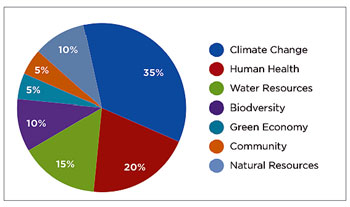The fourth version of LEED formally launched this month, with a goal of pushing the building envelope further than ever before.
Now that LEED – and green building in general – is mainstream and standard practice – the US Green Building Council (USGBC) is raising the bar in some really interesting, important ways.
Because LEED has become so widespread, "buildings are now able to meet the standards almost too easily," Brendan Owens, vice-president for LEED technical development, told KYW Newsradio. “They cracked the code. They figured out how to do it. Which is not a bad thing. But it’s time to reset the bar.”
Most compelling is its new focus on outcomes, rather than rating buildings using a piecemeal approach – which energy and water efficient features does it have, for example. LEED v4 views a building as a functioning entity that impacts the community.
"LEED v4, at its core, provides insight into the synergies within the building system, providing solutions for optimizing performance, and ultimately achieving better environmental, economic and social outcomes in our buildings," explains Scot Horst, senior vice president of LEED. "It is the LEED of the future, where we challenge the marketplace to go further, to make the next great leap toward better, cleaner, healthier buildings where people live and work."
122 beta projects across the world are already using LEED v4.
Developers are now required to engage a Commissioning Authority (CxA) to work with the building team during the design phase. Until now, the role of commissioning has been to make sure the building operates as designed, but now it is elevated to central arbiter of the entire process – from blueprint through ribbon cutting – to ensure a systems focus on energy efficiency.
LEED v4 also encompasses many more building types, increases technical rigor and simplifies the certification process.
Impact categories
LEED v4 poses a critical question: "What should a LEED project accomplish?"
The new goal is for buildings to reach for outcomes, which is reflected in the following priorities for LEED points:

• Reverse contribution to global climate change (35%),
• Enhance human health and well-being (20%),
• Protect and restore water resources (15%),
• Protect, enhance, and restore biodiversity and ecosystem services (10%),
• Promote sustainable and regenerative natural resources cycles (10%),
• Build a greener economy (5%)
• Enhance social equity, environmental justice, and community quality of life (5%).
“One of the things that has been emerging as a goal is net zero energy use,” Owens told KYW NewsRadio. “That’s the next logical step for us, but that’s not the end of the road. We want to get further than that. We want to encourage project teams to think about buildings that generate more energy than they consume, generate clean water instead of discharging dirty water, clean the air.”
Market sectors
Fully 21 building types are now LEED-certifiable with the addition of: new and existing data centers, new and existing warehouse and distribution centers, the hospitality industry, existing schools and retailers, and further development of the multifamily midrise segment.
New, Simplified Credits
To address climate change, encourage greater energy efficiency and the use of nontoxic materials and furnishings, LEED v4 adds new credits that encourage:
- preparation for extreme weather events, rather than average amounts of stormwater
- more stringent carbon offsets
- reducing outdoor water use through water metering
- demand response systems to reduce energy use
- a minimun Energy Star score of 75
- comprehensive preventive maintenance and an ongoing commissioning plan;
- construction and demolition waste management
- low-emission building materials and furnishings, with increased technical rigor for such materials as adhesives and sealants, paints and coatings, flooring systems, composite wood, and agrifiber products;
- options for lighting control and quality
- more stringent requirements for room noise levels, speech privacy, and sound isolation.
Perhaps the most widely discussed changes to LEED are requirements for materials transparency and nontoxic materials – which mandates a better understanding of the products being used in a building and where they come from.
"If you create a really tight, energy-efficient building and fill it full of noxious materials, you’ve created the perfect gas chamber," Beth Heider of USGBC told Architecture Daily.
Dovetailing with LEED v4 launch, USGBC announced its new "Building Health Initiative." It aims to raise awareness of the building-health connection, shifting the market toward building products that promote human wellness.
Cradle to Cradle certification is included in LEED V4, which will even more stringently enforce the environmental qualities of materials used in green buildings.
Better Support
Finally, LEED v4 simplifies the process of submitting information to receive points, and provides a supporting step-by-step guide with videos and tutorials.
Underwriters Lab (UL) Environment is also supporting LEED with a new toolkit that helps building designers select and specify products.
Unfortunately, UL includes Sustainable Forestry Industry (SFI)-certified paper products in its product guidelines, while only Forest Stewardship Council (FSC) forest management certification is accepted under LEED. SFI widely promotes itself as the same as FSC, but as a forest industry-supported certification system – with tons of loopholes – it is pure greenwashing.
With all of this, LEED is still voluntary, while the new US Green Building Code sets a mandatory floor – minimum certification requirements.
